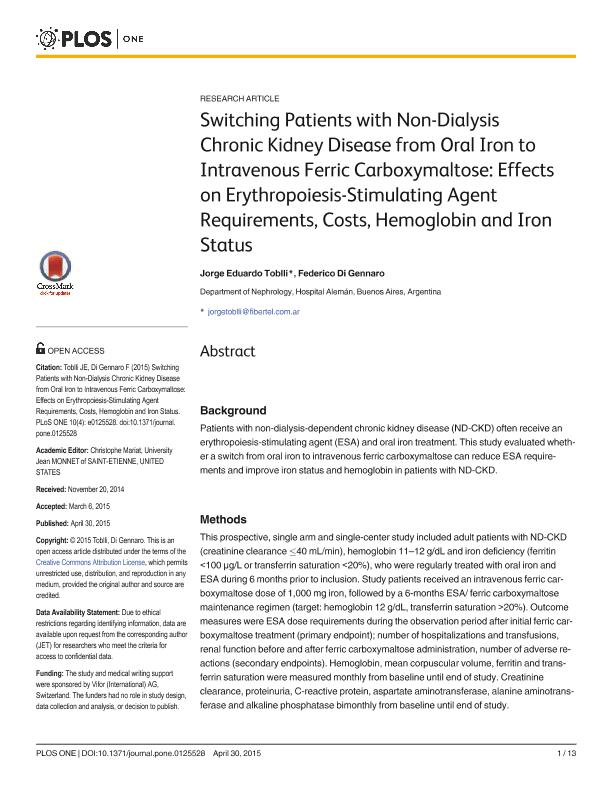Artículo
Switching patients with non-dialysis chronic kidney disease from oral iron to intravenous ferric carboxymaltose: effects on erythropoiesis-stimulating agent requirements, costs, hemoglobin and iron status
Fecha de publicación:
04/2015
Editorial:
Public Library of Science
Revista:
Plos One
ISSN:
1932-6203
Idioma:
Inglés
Tipo de recurso:
Artículo publicado
Clasificación temática:
Resumen
BACKGROUND: Patients with non-dialysis-dependent chronic kidney disease (ND-CKD) often receive an erythropoiesis-stimulating agent (ESA) and oral iron treatment. This study evaluated whether a switch from oral iron to intravenous ferric carboxymaltose can reduce ESA requirements and improve iron status and hemoglobin in patients with ND-CKD. METHODS: This prospective, single arm and single-center study included adult patients with ND-CKD (creatinine clearance ≤40 mL/min), hemoglobin 11-12 g/dL and iron deficiency (ferritin <100 μg/L or transferrin saturation <20%), who were regularly treated with oral iron and ESA during 6 months prior to inclusion. Study patients received an intravenous ferric carboxymaltose dose of 1,000 mg iron, followed by a 6-months ESA/ ferric carboxymaltose maintenance regimen (target: hemoglobin 12 g/dL, transferrin saturation >20%). Outcome measures were ESA dose requirements during the observation period after initial ferric carboxymaltose treatment (primary endpoint); number of hospitalizations and transfusions, renal function before and after ferric carboxymaltose administration, number of adverse reactions (secondary endpoints). Hemoglobin, mean corpuscular volume, ferritin and transferrin saturation were measured monthly from baseline until end of study. Creatinine clearance, proteinuria, C-reactive protein, aspartate aminotransferase, alanine aminotransferase and alkaline phosphatase bimonthly from baseline until end of study. RESULTS: Thirty patients were enrolled (age 70.1±11.4 years; mean±SD). Mean ESA consumption was significantly reduced by 83.2±10.9% (from 41,839±3,668 IU/patient to 6,879±4,271 IU/patient; p<0.01). Hemoglobin increased by 0.7±0.3 g/dL, ferritin by 196.0±38.7 μg/L and transferrin saturation by 5.3±2.9% (month 6 vs. baseline; all p<0.01). No ferric carboxymaltose-related adverse events were reported and no patient withdrew or required transfusions during the study. CONCLUSION: Among patients with ND-CKD and stable normal or borderline hemoglobin, switching from oral iron to intravenous ferric carboxymaltose was associated with significant improvements in hematological and iron parameters and a significant reduction in ESA dose requirements in this single-center pilot study.
Archivos asociados
Licencia
Identificadores
Colecciones
Articulos(ININCA)
Articulos de INST.DE INVEST.CARDIOLOGICAS (I)
Articulos de INST.DE INVEST.CARDIOLOGICAS (I)
Citación
Toblli, Jorge Eduardo; Di Gennaro, Federico; Switching patients with non-dialysis chronic kidney disease from oral iron to intravenous ferric carboxymaltose: effects on erythropoiesis-stimulating agent requirements, costs, hemoglobin and iron status; Public Library of Science; Plos One; 10; 4; 4-2015; 1-13; e0125528
Compartir
Altmétricas




